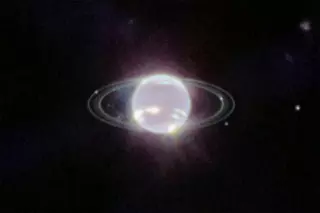
Webb telescope captures the best view of Neptune's rings
text_fieldsThe James Webb Space Telescope has captured the clearest image of Neptune and its rings since the Voyager 2 spacecraft flew by it in 1989. NASA released the image which shows several bright and narrow rings along with fainter dust bands of the icy planet.
Heidi Hammel, a Neptune system expert and an interdisciplinary scientist for Webb, said that this is the first time anyone has seen the rings in infrared. "The very faint rings can be detected by the telescope due to its extremely stable and precise image quality."
Located 30 times farther from the Sun than Earth, the high noon on Neptune is like a dim twilight. The new images show high-altitude clouds as bright streaks and spots.
In the new images, a thin line of brightness is seen around Neptune's equator. It hints at the global atmospheric circulation powering the winds and storms of the planet. The northern pole is out of view because of its 164-year orbit. The Webb image hints at a brightness in the area.
In the NIRCam, Neptune does not appear blue because the methane gas covering the planet strongly absorbs red and infrared light. In the Hubble image, the faraway planet appears blue due to the presence of methane.
The high-power telescope has also captured images of seven of the 14 known moons of Neptune. One of the moons, Triton, looks like a star due to its size and high nitrogen content that reflects 70% of sunlight.























